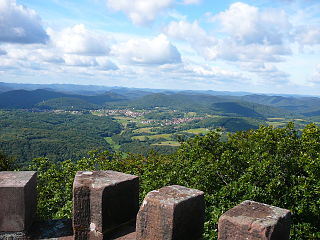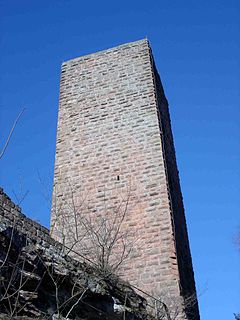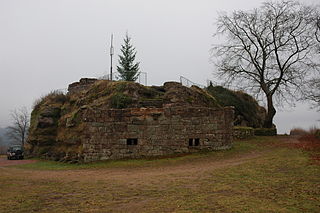| Little France | |
|---|---|
Klein-Frankreich, Thurm Frankreich | |
| Erlenbach bei Dahn | |
 Remains of the battery tower at Little France | |
| Coordinates | 49°06′18″N7°51′46″E / 49.1050°N 7.8628°E Coordinates: 49°06′18″N7°51′46″E / 49.1050°N 7.8628°E |
| Type | hill castle, hillside castle |
| Code | DE-RP |
| Height | 322 m above sea level (NN) |
| Site information | |
| Condition | ruin |
| Site history | |
| Built | 1484 |
| Garrison information | |
| Occupants | knights |
Little France [1] [2] (German : Klein-Frankreich or Kleinfrankreich) is the ruin of a hillside fort in the German region of Dahner Felsenland. It lies above the village of Erlenbach bei Dahn in the county of Südwestpfalz in the state of Rhineland-Palatinate.

German is a West Germanic language that is mainly spoken in Central Europe. It is the most widely spoken and official or co-official language in Germany, Austria, Switzerland, South Tyrol (Italy), the German-speaking Community of Belgium, and Liechtenstein. It is also one of the three official languages of Luxembourg and a co-official language in the Opole Voivodeship in Poland. The languages which are most similar to German are the other members of the West Germanic language branch: Afrikaans, Dutch, English, the Frisian languages, Low German/Low Saxon, Luxembourgish, and Yiddish. There are also strong similarities in vocabulary with Danish, Norwegian and Swedish, although those belong to the North Germanic group. German is the second most widely spoken Germanic language, after English.

The Dahner Felsenland, also referred to as the Dahn Rockland, is a landscape in the county of Südwestpfalz in the German federal state of Rhineland-Palatinate. It is located in the middle section of the Wasgau, which in turn forms the southern part of the Palatine Forest and the northern part of the Vosges in France. The Dahner Felsenland has numerous rock formations within the South Palatinate Climbing Area.

Erlenbach bei Dahn is a municipality in Südwestpfalz district, in Rhineland-Palatinate, western Germany.





















